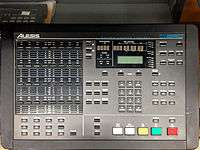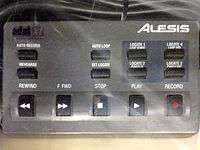ADAT
Alesis Digital Audio Tape (ADAT) is a magnetic tape format used for the recording of eight digital audio tracks onto a Super VHS tape that is used by consumer VCRs.

History
The product was announced in January 1991 at the NAMM convention in Anaheim, California by Alesis. The first ADAT recorders shipped over a year later in February or March 1992.[1] More audio tracks could be recorded by synchronizing up to 16 ADAT machines together, for a total of 128 tracks. While synchronization had been available in earlier machines, ADAT machines were the first to do so with sample-accurate timing - which in effect allowed a studio owner to purchase a 24-track tape machine eight tracks at a time. This capability and its comparatively low cost, originally introduced at $3995, were largely responsible for the rise of project studios in the 1990s.[2]


Several versions of the ADAT machine were produced. The original ADAT (also known as "Blackface") and the ADAT XT recorded 16 bits per sample (ADAT Type I). A later generation of machines—the XT-20, LX-20 and M-20—supports 20 bits per sample (ADAT Type II). All ADAT machines use the same high quality S-VHS tape media. Tapes formatted in the older Type I style can be read and written in the more modern machines, but not the other way around. Later generations record at two sample rates, the 44.1 and 48 kHz rates commonplace in the audio industry. All models allow pitch control by varying the sample rate, and thus tape speed accordingly. An original Blackface could record at 44.1 kHz (or another desired sample rate) if the pitch was lowered or raised by a specific amount. An indicator on the LED display showed when 44.1KHz was reached.
With locate points it was possible to store sample exact positions on tape, making it easy to find specific parts of digital recordings. Using Auto Play and Auto Record functions made it possible to "drop in" at predetermined points, rather than relying on human timing ability to start and stop recording at precisely the right instant.
ADAT machines could be controlled externally with the Alesis LRC (Little Remote Control), which could be attached to the ADAT with a 1/4" tip/sleeve plug, and featured the transport controls and most commonly used functions. Alternatively the BRC[3] (Big Remote Control) could be used, which included many more features which the stand-alone ADAT did not have, such as song naming, more locate points and MIDI Time Code synchronisation.
Current status
ADAT tapes are still available through some pro-audio retailers with products from Maxell, EMTEC (formerly the tape division of BASF).

Although it is a tape-based format, the term ADAT now refers to its successor, the Alesis ADAT HD24, which features hard disk recording rather than the traditional tape-based ADAT, which in turn is now considered obsolete. Many still use the ADAT as a simple I/O (in/out) for transfer of analog to digital signals.
"ADAT" is also currently used as an abbreviation for the ADAT Lightpipe protocol, which transfers eight tracks in a single fiber optic cable. The ADAT cable standard is no longer strictly tied to ADAT tape machines, and is now used by analog-to-digital converters, input cards for digital audio workstations, effects machines, etc. One of the original benefits of utilizing ADAT versus S/PDIF or AES3 was that a single cable could carry up to eight channels of audio. (AES10 (MADI) can now carry up to 64 channels.)
See also
References
- Peterson, George; Robair, Gino [ed.] (1999). Alesis ADAT: The Evolution of a Revolution. Mixbooks. p. 2. ISBN 0-87288-686-7
- George Petersen, "In Memoriam: Keith Barr 1949-2010", Mix Magazine Online, Aug 2010, http://mixonline.com/news/keith_barr_obit_2508/index1.html Archived 2010-08-29 at the Wayback Machine
- Alesis BRC Archived January 3, 2010, at the Wayback Machine
External links
![]()
- DAT-XT 8 Track Digital Audio Recorder(alesis.com/web.archive.org)
- manuals(alesis.com/web.archive.org)